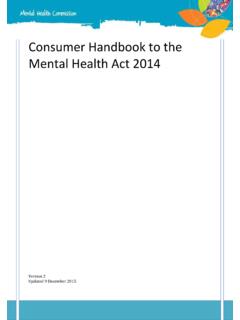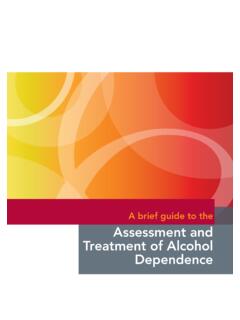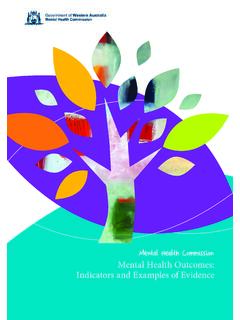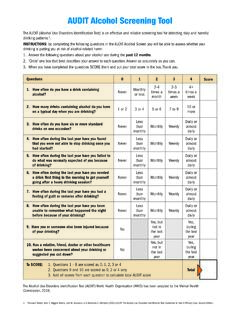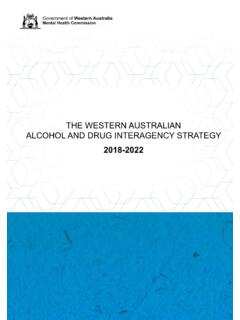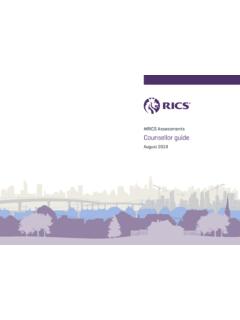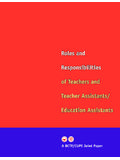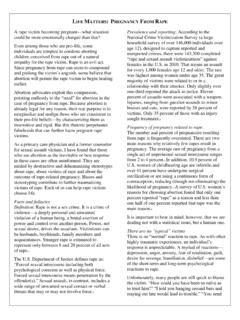Transcription of 3rd edition - Mental Health Commission | Home
1 Counselling guidelines: Alcohol and other drug issues 3rd edition 2013. Ali Marsh, Stephanie O'Toole, Ali Dale, Laura Willis & Sue Helfgott ISBN 978-1-876684-58-7. Western Australian Alcohol and Drug Authority, 2013. Note The Drug and Alcohol Office is the business name of the Western Australian Alcohol and Drug Authority which is an independent statutory authority established in November 1974. Its functions are set out in the Alcohol and Drug Authority Act 1974. This resource was produced by Workforce Development Branch and Next Step Drug and Alcohol Services, Drug and Alcohol Office. For further information: Workforce Development Branch, Drug and Alcohol Office, PO Box 126, Mount Lawley WA 6929.
2 Website: Table of Contents 1. Principles of effective 1. 2. Stages of 2. 2. 2. 2. 3. 3. 3. Ingredients of effective 4. A strong therapeutic 4. Assessment, case conceptualisation and treatment 5. Effective case 5. Specific 5. Addressing 6. Managing 6. Professional development and 7. 4. 8. The assessment 8. Raising sensitive issues in the assessment 13. A note on 13. Standardised 14. Documenting the 16. Treatment 5. Suicide assessment and 20. Assessing suicide 20. Chronic 22. 6. Case 26. Format of a case 26. Example of a case 26. Feedback of the case formulation to 27. Documenting the 27. 7. Motivational 29. The relational component of 30.
3 The good things' about AOD use (sustain).. 30. Less good things (change).. 30. 31. The technical 31. Evoking and enhancing client change 32. The 33. 8. 34. 34. Define the 34. Brainstorm 34. 34. Planning how to implement the 35. Putting the plan into action and evaluating the 35. page ii Counselling guidelines: Alcohol and other drug issues | 3rd edition Table of Contents 9. Goals of 36. Issues to consider when setting 36. Geared towards the client's stage of 36. 36. Specific and 36. 36. Described in presence' rather than absence' 37. Not necessarily limited to drug 37. SMART 37. Questions to help clients think through their 37.
4 10. Treatment 39. 11. Case 40. Primary case 40. Shared case 41. 12. 43. 13. Waitlist management and follow 44. 14. Case 45. Principles of client record 45. Incident 46. Recording information related to 46. 15. Relapse prevention and 48. Rationale and demystification of 48. Enhancing the 48. Identifying high-risk 48. Developing coping 49. Helpful 49. Preparation for a 49. Relapse 49. 16. Harm 51. Harm reduction and AOD 51. Negotiating less risky 51. 17. Brief 53. 18. Cognitive 55. Common thinking 55. The ABCDE 57. 19. Relaxation 59. Controlled 59. Progressive muscle 59. Visual imagery to create a safe 61. 20. 62. 21.
5 64. Formal mindfulness 64. Mindfulness of the 64. Mindfulness of 65. Mindfulness of thoughts: cognitive 66. Informal mindfulness 66. Making up simple mindfulness strategies for 66. Mindfulness and cognitive behaviour 67. The therapeutic relationship and 67. Counselling guidelines: Alcohol and other drug issues | 3rd edition page iii Table of Contents 22. Anger 69. Anger management 69. 23. Assertiveness 72. Steps in assertiveness 72. 24. Group 75. Stages of group 76. 25. Residential 78. Suitability for residential 78. Engaging clients into residential 78. Therapeutic 79. 80. 26. Managing intoxicated 82. How to approach intoxicated 82.
6 Some general guidelines for managing 82. Managing methamphetamine 83. 27. Managing aggressive 84. Avoid triggering an aggressive 84. Managing safety with an aggressive 84. Communicating with an aggressive 84. 28. Critical 86. Principles of psychological first 86. 86. Documenting critical 87. 87. 29. Withdrawal 89. 90. 91. 91. 92. 92. Scales for assessing 92. Supportive 93. 30. Pharmacotherapies for AOD 95. Pharmacotherapies for opioid 95. 95. 96. 97. Pharmacotherapies for alcohol 97. 97. 97. 98. Pharmacotherapies for other drugs of 98. 31. Pain management for dependent 100. Acute and chronic 100. Multidisciplinary management of chronic 100.
7 Cognitive-behavioural approaches for pain 101. page iv Counselling guidelines: Alcohol and other drug issues | 3rd edition Table of Contents 32. 104. Managing 104. Managing 104. 105. Harm 106. Cognitive 106. Stepped care 107. 33. Volatile substance 109. Interventions for 109. 34. Co-occurring severe Mental 35. Co-occurring Recommended treatment 36. Co-occurring Recommended treatment 37. Co-occurring trauma 123. Posttraumatic stress disorder (PTSD).. 123. Complex 123. Recommended treatment 125. Rehabilitation model of trauma 125. Developing a life beyond the trauma (integration).. 129. 38. Grief and 131. 131. Goals of grief 132.
8 Useful 133. General points when working with 134. Client 135. 39. Cognitive 137. Alcohol and cognitive 137. Illicit drug use and cognitive 137. Volatile substance use and cognitive 138. Assessment of cognitive 138. Managing cognitive 139. 40. Coerced 41. Incarcerated 143. 42. Significant 144. Assumptions of family inclusive 144. Working with significant others as clients in their own 145. Working with significant others as an adjunct to a client's AOD 146. 146. Some issues specific to 146. 43. Young 149. Developmental issues and 149. Risk and protective 149. Treatment 150. Child protection 152. Counselling guidelines: Alcohol and other drug issues | 3rd edition page v Table of Contents 44.
9 Child protection 154. Definitions of abuse and 154. Assessment and management of child 154. 45. Parenting 158. 46. Gender 161. Working with 161. Working with 162. 47. Alcohol, other drugs and 163. Alcohol and 163. What is FASD?.. 164. Prevention of 165. Prevention of FASD in pregnant women who are 165. Prevention of FASD in all female clients of childbearing 165. Access to 166. Aboriginal and Torres Strait Islander 166. Continuity of 167. Child 167. 167. Other drugs and 167. Methamphetamine/amphetamine-type 167. 167. 167. Volatile 168. General principles for responding to drug use and 168. 48. Culturally and linguistically diverse 172.
10 Barriers to accessing AOD 172. Improving AOD treatment 172. Improving the AOD treatment 173. 49. Aboriginal Culturally secure ways of 50. 179. 51. Clinical 180. What makes effective supervision?.. 181. Obligations of the 182. Group 182. Reviewing recordings and case notes in 183. 52. Stress and 185. 53. Vicarious 187. What is vicarious trauma?.. 187. The physiological basis of 187. Other factors that contribute to the development of 188. Work-related 188. Helper-related 188. Sociocultural 189. Preventing and responding to 189. Strategies to reduce physiological responses to 189. General personal and professional self-care 190.


